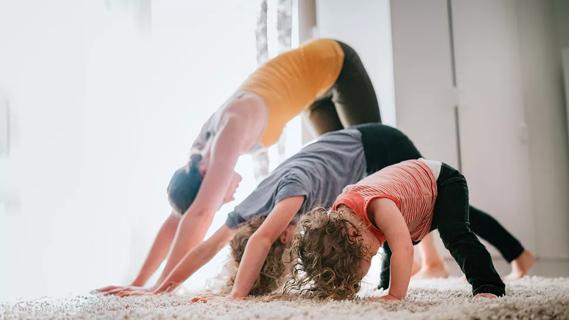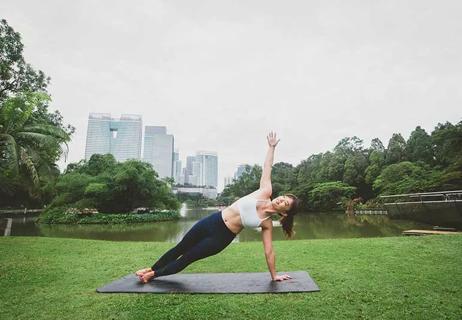Focus on inhaling and exhaling through 12 steps of a complete sequence
Yoga often involves continuous, flowing movement from one pose to the next. As you move, you focus on your breath and how you feel in your physical body.
Advertisement
Cleveland Clinic is a non-profit academic medical center. Advertising on our site helps support our mission. We do not endorse non-Cleveland Clinic products or services. Policy
Sun salutations are just one common example of how several poses can be combined to create a full-body practice that is both physically and mentally fulfilling. It has long been used as a way to honor the sun and engage in self-reflection year-round. In addition to its ancient yogic roots, it’s become a common practice in your average, modern yoga class.
Occupational therapist and yoga instructor Lynda Robinson, OT/L, RYT-500, explains how you can benefit from sun salutations and how to do them.
Sun salutations (or Surya Namaskar) are a complete yoga practice that blends movement with breathwork (pranayama) to build awareness and strengthen the mind-body connection. This practice has deep cultural and spiritual roots as a way of honoring the sun. It originates from the Rig Veda, an ancient Indian collection of Sanskrit hymns.
Today, different styles of yoga practice sun salutations in different ways. But each version involves a series of poses or movements that can be done individually or as a complete sequence.
“Sun salutations have survived through various yogic lineages for thousands of years,” says Robinson. “A lot of people prefer to practice sun salutations at sunrise, while facing the rising sun. But you can do this practice at any time of day. It’s also accessible for anyone who’s able to get down and up from the floor.”
Advertisement
By doing Surya Namaskar (or any yoga, really), you benefit from improved:

There are many different kinds of yoga, and each does Surya Namaskar in its own way, with various similarities and differences. For example, some might incorporate poses like warrior pose, while others may not. You can practice what feels right for you.
As Robinson is trained in the Kriya and Hatha styles of yoga from the Bihar Yoga Bharati Institute, we’ll describe how to do sun salutations in that approach.
“It’s a classical style of yoga that’s extremely accessible from an exercise and adaptability standpoint,” says Robinson.
A full sun salutation in this style involves a steady flow of 12 poses repeated twice in a single sequence for a total of 24 steps. In some traditional practices, people will do 108 sun salutations during the summer solstice as a way to honor the changing of seasons. But you can do as many sun salutations as you feel comfortable year-round.
“It doesn’t have to be long and drawn out,” she clarifies. “It can be done in five minutes or 15 minutes. It’s up to you how many you want to do and what you want to get out of it.”
Robinson covers all 12 steps of a sun salutation and its preparatory phase. Keep in mind, each of these steps is meant to flow directly into the next.
Tadasana has many names (like standing mountain pose), but it offers a silent moment of clarity before you begin a sun salutation.
Sometimes called “Prayer Pose,” this is the foundational first step to a sun salutation meant to increase your awareness as you focus on your breath.
Advertisement
Advertisement
The cow pose provides more support and an easier transition for those who find the eight-limbed pose too difficult.
This pose is a simpler transition out of the cow pose and a good alternative to cobra.
Advertisement
Overall, Robinson recommends flowing through all 12 steps at least four times for two complete sun salutations in a single practice.
You can do more (or less) as you see fit, but the goal of the overall practice is to focus on how you feel in your mind, body and breath as you move through each pose.
“It helps to focus on one pose or a couple of poses at first to really understand each one before you complete a whole sequence,” she adds.
Note that some people may feel lightheaded or dizzy while doing this practice because of the breath work that’s involved and because blood rushes to your head when you’re bending over or inverted (like with downward dog)
Robinson cautions anyone with a history of stroke or heart conditions and anyone on heart medications to talk with a physical therapist or healthcare provider before doing these poses. And if at any point you feel dizzy or experience pain, stop what you’re doing and slip into the Savasana pose:
“Savasana is always an option if you need to take a break, and it’s a great pose to use at the end of any practice,” says Robinson. “Lie there until you feel total relaxation, your breathing rate comes down and your heart rate comes back to normal.”
Learn more about our editorial process.
Advertisement

This gentle yoga stretch supports your spine, strengthens your core and calms your mind

Stand tall and feel grounded with this foundational yoga pose

This transitional and restorative yoga pose provides a full-body stretch

Somatic yoga focuses on the sensation and experience of movement — not striking perfect poses

Balasana, or child’s pose, is a restorative full-body yoga technique

Kids’ yoga can help kiddos become more aware of their physical, mental and emotional selves

This mindful practice is designed to give you mental and physical relaxation

You can work more than your abdominals

Leg-related symptoms indicate DVT, while chest symptoms point to a pulmonary embolism

There are many different ways to love someone and yourself

Looking down at your smartphone or computer screen can stress muscles in your neck, shoulders and back